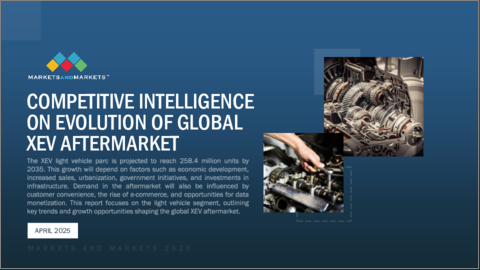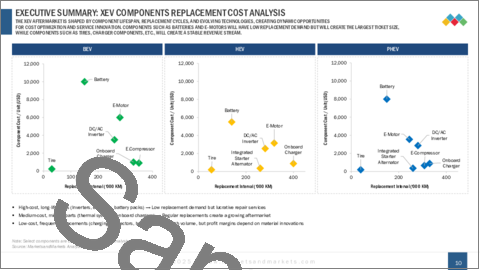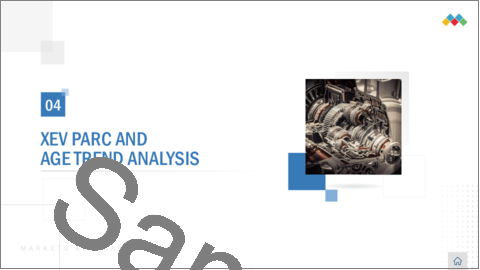|
|
市場調査レポート
商品コード
1711379
世界のxEV(電動車)アフターマーケットの進化に関する競合インテリジェンス:推進方式別、コンポーネント別、地域別 - 2035年までの予測Competitive Intelligence on the Evolution of Global XEV Aftermarket by Propulsion, Components, Region - Global Forecast to 2035 |
||||||
カスタマイズ可能
|
|||||||
| 世界のxEV(電動車)アフターマーケットの進化に関する競合インテリジェンス:推進方式別、コンポーネント別、地域別 - 2035年までの予測 |
|
出版日: 2025年04月17日
発行: MarketsandMarkets
ページ情報: 英文 55 Pages
納期: 即納可能
|
全表示
- 概要
- 図表
- 目次
世界のxEV(電動車)アフターマーケットは2024年に590億米ドル、2035年には1,950億米ドルに達すると予測され、2024年から2035年までのCAGRは11.5%とみられています。
xEVアフターマーケットは、主要地域でのXEV普及率の上昇、平均年齢と年間走行距離の上昇、アフターマーケットにおける新興サービス需要など、様々な要因によって成長が見込まれています。
| 調査範囲 | |
|---|---|
| 調査対象年 | 2024年~2035年 |
| 基準年 | 2024年 |
| 予測期間 | 2024年~2035年 |
| 対象台数 | 数量(台)および金額(100万米ドル) |
| セグメント別 | 推進方式別、コンポーネント別、地域別 |
| 対象地域 | 中国、アジア太平洋、欧州、北米、その他の地域 |
電気自動車(EV)は、そのユニークな技術的・運用的特性により、アフターマーケットサービスに変革の時代を到来させようとしています。内燃エンジンから電動パワートレインへのシフトは、革新的なサービスモデルを導入する一方で、「4R」の原則(修理、再利用、リサイクル、再生産)にまつわる機会を拡大すると思われます。移動式サービスユニットが脚光を浴び、EVのオンデマンド・メンテナンスや診断を提供し、所有者のダウンタイムを短縮します。古い車両を電気システムに改造することで、クラシックカーや老朽化した車両に新たな息吹が吹き込まれ、持続可能性とカスタマイズが融合します。EVの定期メンテナンスは、可動部品が少ないため簡素化されるとはいえ、高電圧システムやソフトウェア・アップデートに関する専門スキルが要求されるようになり、熟練技術者のニッチ分野が形成されます。バッテリーのセカンドライフ適用は重要なトレンドとして台頭し、使用済みのEVバッテリーを家庭や送電網のエネルギー貯蔵に再利用することで、EVバッテリーの価値を車外に拡大します。さらに、モーター、コントローラー、充電器などのEV部品の再製造も、費用対効果の高い代替品へのニーズと循環型経済の実践に後押しされて成長すると思われます。これらの開発は、技術主導のソリューションと持続可能なイノベーションを融合させ、アフターマーケットの展望を再定義します。
OEMは、自動車産業が電動化に移行する中で、EVの修理・メンテナンスから安定した収入源を確保するために戦略的な方向転換を行っています。従来の自動車とは異なり、EVは機械的なメンテナンスの頻度が低いため、OEMはバッテリーの健康状態のモニタリング、ソフトウェアのアップデート、電気ドライブトレインの特殊な修理など、価値の高いサービスに注力しています。デジタル化はこのシフトにおいて極めて重要な役割を果たし、OEMはOTA(Over-the-Air)アップデートを活用して継続的な改善を提供し、問題を遠隔でトラブルシューティングし、サブスクリプションベースの機能を提供することで、顧客ロイヤルティを高めながら継続的な収益を生み出すことができます。テレマティクスとコネクテッド・ビークル・プラットフォームにより、OEMは車両性能に関するリアルタイムのデータを収集し、メンテナンスの必要性を予測し、パーソナライズされたサービス・パッケージを提供することで、サードパーティの修理工場への依存を減らすことができます。さらにOEMは、バッテリーパックの整備などの複雑な修理を管理するために、認定サービスネットワークとトレーニングプログラムを確立し、バッテリーのリサイクルやセカンドライフ用途のパートナーシップを模索しています。デジタルツールを統合することで、OEMは業務を合理化し、コストを削減し、EVエコシステムにおけるエンド・ツー・エンドのソリューション・プロバイダーとしての地位を確立することができます。
EVサービス市場の進化に伴い、相手先商標製品メーカー(OEM)と独立系アフターマーケット(IAM)プレーヤーは、足場を確保するために独自の戦略を練っています。OEMは、独自のソフトウェア、診断、バッテリーシステムの管理を強化し、OTA(Over-The-Air)アップデートやテレマティクスのようなデジタル化を利用して顧客を囲い込み、高価値の修理を支配しています。IAMは、独占的なサービスネットワークを構築し、認定トレーニングを提供し、メンテナンスを保証に結びつけることで、EVオーナーが自社のエコシステムを信頼するようにしています。逆に、IAMはこのOEMの牙城を崩すという課題に直面しています。これに対抗するため、IAMはリバースエンジニアリングツールに投資し、サードパーティの診断ソリューションを開発し、EVのデータやソフトウェアコードにアクセスするための「修理権」規制を求めるロビー活動を行うと思われます。IAMは、再生部品、バッテリーの再製造、移動式修理装置など、コスト競争力のある製品に重点を置き、保証期間外の価格に敏感な消費者にアピールします。
IAMの中には、認定スペアパーツやサービス契約のためにOEMと提携し、競争と共存のバランスをとるところもあります。IAMは、古いEVのレトロフィットや、OEMの優位性が薄れている保証期間外の車両のサービスにおいて、ニッチを切り開くかもしれません。一方、持続可能性を求める消費者の要求は、バッテリーのセカンドライフ・プログラムを提供するOEMと、地域密着型のリサイクル・ソリューションを提供するIAMの双方を革新に向かわせる可能性があります。この戦いは、デジタルアクセス、規制の変化、ソフトウェアアップデートや高電圧システムの修理といったEV特有のニーズへの適応能力にかかっています。
この市場分析では、xEVアフターマーケット市場を網羅し、販売とxEVに焦点を当てています。さらに、2024年のxEVアフターマーケットにおける部品需要を調査しています。当レポートは、xEVアフターマーケット分野を推進する動向を掘り下げ、2035年までに業界に影響を与える要因を分析しています。地域間の平均走行距離と平均年齢、eコマースとデジタル化がアフターマーケットに与える影響、OES V IAMベンチマーク戦略など、幅広い要素を網羅しています。
当レポートは、2024年のxEVアフターマーケットとそのサブセグメントにおける販売台数と台数の最も近い概算値に関する情報を提供し、市場リーダーと新規参入者の助けとなります。当レポートは、利害関係者が競合情勢を理解し、自社のビジネスをより良く位置づけ、適切な市場参入戦略を計画するためのより多くの考察を得るのに役立ちます。また、利害関係者が市場の脈動を理解し、主要市場促進要因・課題・機会に関する情報を提供するのに役立ちます。
目次
第1章 エグゼクティブサマリー
第2章 調査目的、範囲、調査手法
第3章 マクロ経済分析と規制分析
- 地域別GDP成長予測
- 地域別世界インフレ率
- 2030年までの世界の原油価格とリチウムイオン電池価格の動向
第4章 XEV PARCと年齢の傾向分析
- XEV PARC、地域別・推進方式別
- XEV PARC分析、推進方式別・地域別
- XEVの燃費動向
- XEV平均年数の動向
第5章 XEVコンポーネントのアフターマーケット
- 世界:XEVアフターマーケット(推進方式別、地域別、コンポーネント別)
- 欧州:XEVアフターマーケット(推進方式別、コンポーネント別)
- 北米:XEVアフターマーケット(推進方式別、コンポーネント別)
- 中国:XEVアフターマーケット(推進方式別、コンポーネント別)
- アジア太平洋(中国を除く):XEVアフターマーケット(推進方式別、コンポーネント別)
- その他の地域:XEVアフターマーケット(推進方式別、コンポーネント別)
第6章 ハイブリッド車と電気自動車向けの新興サービス
- バッテリーリサイクル
- EV改造
- バッテリーの再利用
- EVサービスのメンテナンスと修理
- モバイルサービスユニット
- EV充電サービス
第7章 OEM XEVアフターセールス戦略
第8章 OESとIAMのベンチマーク
第9章 主要な成長機会と提言
第10章 結論とサマリー
List of Tables
_
List of Figures
_
The global xEV aftermarket was USD 59 billion in 2024 and is projected to reach USD 195.0 billion in 2035, witnessing a CAGR growth of 11.5% from 2024 to 2035. The xEV aftermarket is expected to experience growth driven by various factors, such as the rising penetration of XEVs across the key regions, rising average age and miles traveled in a year, and demand for emerging services in the aftermarket.
| Scope of the Report | |
|---|---|
| Years Considered for the Study | 2024-2035 |
| Base Year | 2024 |
| Forecast Period | 2024-2035 |
| Units Considered | Volume (Units) and Value (USD Million) |
| Segments | by Propulsion, Components, Region (China, APAC excl. China, Europe, NA, RoW) - Global Forecast to 2035 |
| Regions covered | China, APAC, Europe, NA, RoW |
"EV to bring a very transformative change in the automotive aftermarket."
Electric vehicles (EVs) are poised to usher in a transformative era for aftermarket services, driven by their unique technological and operational characteristics. The shift from internal combustion engines to electric powertrains will expand opportunities around the "4R" principles-repair, reuse, recycle, and remanufacture-while introducing innovative service models. Mobile service units will gain prominence, offering on-demand maintenance and diagnostics for EVs, reducing downtime for owners. Retrofitting older vehicles with electric systems will breathe new life into classic cars and aging fleets, blending sustainability with customization. Routine EV maintenance, though simpler due to fewer moving parts, will demand specialized skills in high-voltage systems and software updates, creating a niche for skilled technicians. Battery second-life applications will emerge as a key trend, repurposing used EV batteries for energy storage in homes or grids, extending their value beyond the vehicle. Additionally, EV part remanufacturing-such as motors, controllers, and chargers-will grow, fueled by the need for cost-effective replacements and circular economy practices. Together, these developments will redefine the aftermarket landscape, blending tech-driven solutions with sustainable innovation.
"OEMs strategizing to become a major stakeholder in xEV aftermarket."
Original Equipment Manufacturers (OEMs) are strategically pivoting to secure stable income streams from EV repair and maintenance as the automotive industry transitions to electrification. Unlike traditional vehicles, EVs require less frequent mechanical upkeep, prompting OEMs to focus on high-value services like battery health monitoring, software updates, and specialized repairs for electric drivetrains. Digitalization plays a pivotal role in this shift, enabling OEMs to leverage over-the-air (OTA) updates to deliver continuous improvements, troubleshoot issues remotely, and offer subscription-based features-creating recurring revenue while enhancing customer loyalty. Telematics and connected vehicle platforms allow OEMs to collect real-time data on vehicle performance, predict maintenance needs, and offer personalized service packages, reducing reliance on third-party repair shops. Additionally, OEMs are establishing certified service networks and training programs to retain control over complex repairs, such as battery pack servicing, while exploring partnerships for battery recycling and second-life applications. By integrating digital tools, OEMs can streamline operations, cut costs, and position themselves as end-to-end solution providers in the EV ecosystem.
"xEVs to intensify the competition between IAM and OES players"
As the EV servicing market evolves, Original Equipment Manufacturers (OEMs) and Independent Aftermarket (IAM) players are crafting distinct strategies to secure their foothold. OEMs are doubling down on their control over proprietary software, diagnostics, and battery systems, using digitalization-like over-the-air (OTA) updates and telematics-to lock in customers and dominate high-value repairs. They're building exclusive service networks, offering certified training, and tying maintenance to warranties, ensuring EV owners rely on their ecosystem. Conversely, IAMs face the challenge of breaking this OEM stronghold, particularly around proprietary software. To compete, IAMs are likely to invest in reverse-engineering tools, develop third-party diagnostic solutions, and lobby for "right-to-repair" regulations to access EV data and software codes. They'll focus on cost-competitive offerings, such as refurbished parts, battery remanufacturing, and mobile repair units, appealing to price-sensitive consumers outside warranty periods.
Collaboration could also emerge, with some IAMs partnering with OEMs for authorized spare parts or service contracts, balancing competition with coexistence. IAMs might carve niches in retrofitting older EVs or servicing out-of-warranty vehicles, where OEM dominance wanes. Meanwhile, consumer demand for sustainability could push both to innovate-OEMs with battery second-life programs and IAMs with localized recycling solutions. The battle will hinge on digital access, regulatory shifts, and the ability to adapt to EV-specific needs like software updates and high-voltage system repairs.
Research Coverage:
The market analysis encompasses the xEV aftermarket market, focusing on the sales & xEVs . Additionally, it examines the demand for components in the xEV aftermarket in 2024. The report delves into the trends propelling the xEV aftermarket sector, analyzing factors influencing the industry by 2035. The study encompasses a broad range of factors like average mileage & average age across regions, the impact of e-commerce and digitalization on the aftermarket, OES V IAM benchmarking strategies, etc.
Report Scope
The report will help market leaders and new entrants with information on the closest approximations of the sales & parc numbers for the xEV Aftermarket in 2024 and their subsegments. This report will help stakeholders understand the competitive landscape and gain more insights to better position their businesses and plan suitable go-to-market strategies. The report also helps stakeholders understand the market pulse and provides information on key market drivers, restraints, challenges, and opportunities.
The report provides insights on the following pointers:
- Analysis of regional parc volume and regional components demand in XEVs.
- Analysis of key emerging services (battery recycling, retrofitment, battery second life usage, predictive maintenance, remote onboard diagnostics, integration of sustainability, mobile service units, EV charger aggregators, etc.).
- Analysis of OEM XEV Aftersales strategies, which includes aftersale strategies and business models offered by different OEMs
- OES Vs IAM Benchmarking: Detailed insights OES vs Aim penetration in the EV maintenance space, OEM vs IAM customer retention and acquisition strategies, details about infrastructure and investments.
- Market Development: Comprehensive information about lucrative markets - the report analyses the XEV aftermarket across varied regions
- Competitive Assessment: This section assesses the market shares, growth strategies, and service offerings of leading players across xEV segments. The report also helps stakeholders understand the pulse of the aftermarket components and services market and provides them with information on key market drivers, challenges, and opportunities.
TABLE OF CONTENTS
1 EXECUTIVE SUMMARY
- 1.1 GLOBAL LIGHT VEHICLE PARC TRENDS
- 1.2 ICE VS XEV AFTERMARKET REVENUE ANALYSIS
- 1.3 ICE VS XEV COMPONENTS MAINTENANCE COST PER MILE AND REPLACEMENT INTERVAL
- 1.4 AFTERMARKET REVENUE IMPACT DUE TO PENETRATION OF BEVS
- 1.5 XEV COMPONENTS REPLACEMENT COST ANALYSIS
- 1.6 EMERGING SERVICES FOR HYBRID AND ELECTRIC VEHICLES
2 STUDY OBJECTIVES, SCOPE, AND METHODOLOGY
- 2.1 STUDY SCOPE
- 2.2 STUDY OBJECTIVES AND METHODOLOGY
3 MACROECONOMIC ANALYSIS & REGULATORY ANALYSIS
- 3.1 GDP GROWTH PROJECTIONS BY REGION
- 3.2 GLOBAL INFLATION RATE BY REGION
- 3.3 GLOBAL CRUDE OIL PRICE VS. LITHIUM-ION BATTERY PRICE TRENDS TILL 2030
4 XEV PARC AND AGE TREND ANALYSIS
- 4.1 XEV PARC BY REGION & PROPULSION
- 4.2 XEV REGIONAL PARC ANALYSIS BY PROPULSION
- 4.3 XEV MILEAGE TRENDS
- 4.4 XEV AVERAGE AGE TRENDS
5 XEV COMPONENTS AFTERMARKET
- 5.1 GLOBAL: XEV AFTERMARKET BY PROPULSION, REGION & COMPONENT
- 5.2 EUROPE: XEV AFTERMARKET BY PROPULSION & COMPONENT
- 5.3 NORTH AMERICA: XEV AFTERMARKET BY PROPULSION & COMPONENT
- 5.4 CHINA: XEV AFTERMARKET BY PROPULSION & COMPONENT
- 5.5 APAC (EXCL. CHINA): XEV AFTERMARKET BY PROPULSION & COMPONENT
- 5.6 ROW: XEV AFTERMARKET BY PROPULSION & COMPONENT
6 EMERGING SERVICES FOR HYBRID & ELECTRIC VEHICLES
- 6.1 BATTERY RECYCLING
- 6.2 EV RETROFITMENT
- 6.3 BATTERY SECOND LIFE USAGE
- 6.4 EV SERVICES IN THE MAINTENANCE AND REPAIRS
- 6.5 MOBILE SERVICE UNITS
- 6.6 EV CHARGING SERVICES





